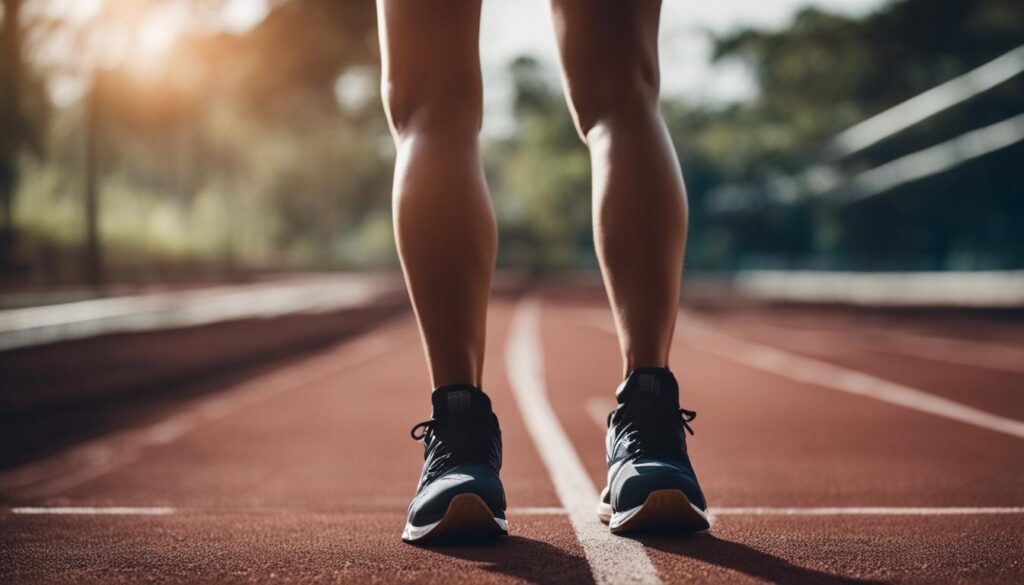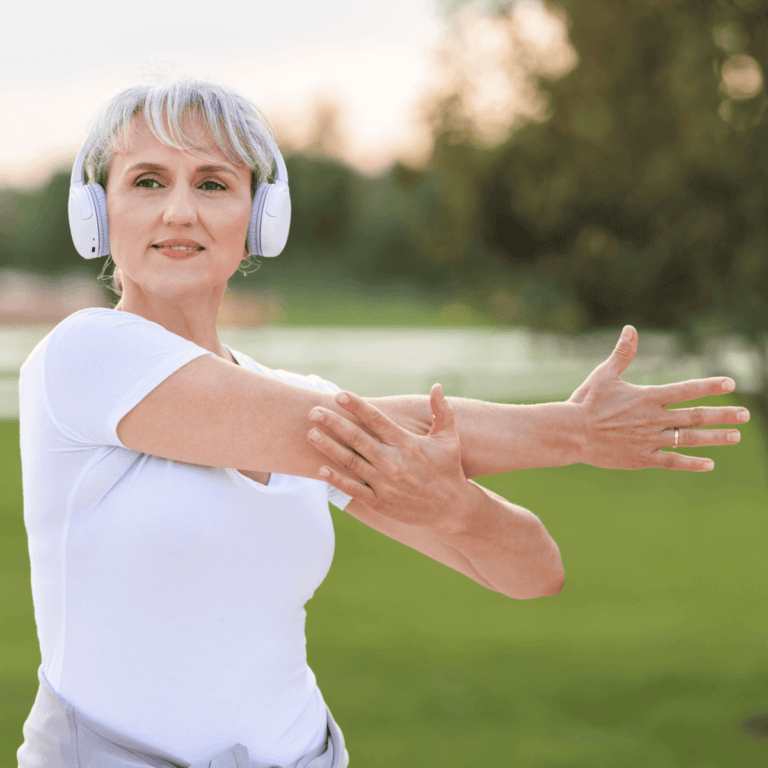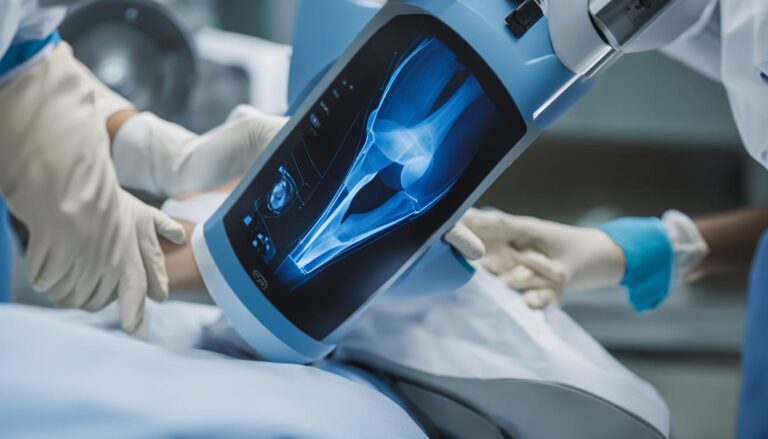Knee Pain After Running: Causes & Relief Tips
Are you experiencing knee pain after running? You’re not alone. Many individuals, including runners, often encounter this issue known as runner’s knee or patellofemoral pain syndrome. It’s crucial to understand the causes of knee pain after running and how to manage and find relief from it.
Knee pain after running can be triggered by various factors, such as overuse, direct impact, malalignment, problems with your feet, or weak thigh muscles. The pain is typically felt in the front of the knee and can worsen during activities like walking, squatting, or running downhill. It’s essential to diagnose and treat this condition properly to prevent further injury and promote recovery.
Key Takeaways:
- Runner’s knee, or knee pain after running, is a prevalent issue that can affect not only runners but also those who engage in high-stress exercises.
- The pain is usually felt in the front of the knee and worsens during certain movements.
- Diagnosing runner’s knee involves a physical examination and potentially imaging tests.
- Treatment options include rest, ice, compression, elevation, over-the-counter pain medications, stretching and strengthening exercises, shoe inserts, and, in rare cases, surgery.
- Prevention strategies include thigh muscle strengthening, weight management, warm-up exercises, proper footwear, selecting suitable running surfaces, and seeking guidance from a physical therapist.
Common Causes of Knee Pain After Running
Knee pain after running can be attributed to various factors. Identifying the underlying cause is essential for implementing effective treatment and prevention strategies. Some common causes of knee pain after running include:
- Overuse: Repetitive bending and engaging in high-stress exercises can lead to overuse of the knee joint, resulting in irritation of the tissues around the kneecap.
- Direct Impact: A direct hit to the knee, whether from a fall or blow, can cause immediate pain and discomfort.
- Malalignment: When bones from the hip to the ankle are not properly aligned, excessive pressure can be placed on specific spots, disrupting the smooth movement of the kneecap.
- Problems with Feet: Issues such as hypermobile feet, fallen arches, or overpronation can affect walking patterns and contribute to knee pain.
- Weak Thigh Muscles: Insufficient support from weak or unbalanced thigh muscles, especially the quadriceps, can lead to malalignment and discomfort during knee movement.
By understanding these common causes, individuals can better manage and prevent knee pain after running. Treatment plans can be tailored to target specific causative factors, alleviating pain and promoting optimal knee health.
Symptoms and Diagnosis of Runner’s Knee
Runner’s knee, also known as patellofemoral pain syndrome, is characterized by pain in the front of the kneecap. However, the pain can also occur around or behind the kneecap, affecting various areas of the knee. The location of the pain can provide valuable insights into the underlying cause of the condition.
This type of knee pain is typically aggravated by activities that involve bending the knee, such as walking, squatting, or running downhill. If you experience pain during these movements, it could be a sign of runner’s knee. Additionally, swelling around the knee may accompany the pain, indicating inflammation in the joint.
Another possible symptom of runner’s knee is a popping or grinding sensation when moving the knee. This sensation may occur due to the irregular movement of the kneecap or rubbing between the bones and cartilage. If you feel or hear these noises, it’s essential to seek medical attention for further evaluation.
Runner’s knee can also lead to difficulty performing certain movements. This can include activities that require knee flexibility or strength, such as climbing stairs or squatting. If you notice limitations in your range of motion or experience pain during specific movements, it could be a sign of runner’s knee.
A thorough physical examination conducted by a healthcare professional is crucial for diagnosing runner’s knee. During the exam, the doctor will assess the knee for signs of tenderness, swelling, and abnormalities in the movement of the kneecap. They may also evaluate your gait, assessing how you walk or run to identify any biomechanical issues that could contribute to the condition.
Imaging tests, such as X-rays or MRI scans, may be recommended to evaluate the structure of the knee joint. These tests can provide detailed images of the bones, cartilage, and soft tissues, helping to identify any underlying damage or abnormalities that may contribute to runner’s knee.
Treatment and Management of Knee Pain After Running
When it comes to addressing knee pain after running, a comprehensive approach combining conservative treatments and, in severe cases, surgical intervention is often necessary. Our goal is to provide relief, promote healing, and enhance the overall function of the knee joint. Here are some key treatment options and management strategies:
Rest
Resting the knee is essential for allowing the joint to heal. By avoiding activities that worsen the pain, we give the affected area the time it needs to recover properly.
Ice and Compression
Applying ice to the affected area can help reduce pain and swelling. Combining ice therapy with compression techniques, such as using an elastic bandage or knee sleeve, can further aid in alleviating discomfort and promoting healing.
Elevation
Elevating the leg when resting can help reduce inflammation by allowing excess fluid to drain away from the knee. Keeping the knee elevated above the level of the heart is ideal for maximizing the benefits of elevation.
Pain Medications
Over-the-counter pain medications such as ibuprofen or naproxen can provide temporary relief from knee pain. However, it is essential to follow the label instructions or consult a healthcare professional for proper usage to ensure safety and effectiveness.
Stretching Exercises
Engaging in targeted stretching exercises, particularly those that focus on strengthening the quadriceps muscles, can help improve knee stability and reduce pain. A physical therapist or qualified healthcare professional can guide you in designing a personalized stretching routine.
Shoe Inserts
Proper footwear plays a crucial role in managing knee pain after running. In some cases, shoe inserts or orthotics may be recommended to provide additional support and correct walking patterns. It is essential to choose inserts that are suitable for your specific needs and consult with a professional if necessary.
Surgery
In rare cases of severe runner’s knee, surgery may be necessary to address underlying issues such as damaged cartilage or misalignment of the kneecap. Surgical interventions aim to repair, replace, or realign the affected structures to restore proper joint function. Decisions regarding surgery should be made in consultation with a qualified orthopedic surgeon.
By combining these treatment options, we can effectively manage knee pain after running and improve overall knee health. It is crucial to take a holistic approach and tailor the treatment plan to suit individual needs. Remember, proper rest, targeted interventions, and follow-up care are key to long-term recovery and injury prevention.

| Treatment | Description |
|---|---|
| Rest | Avoid activities that exacerbate the pain and allow the knee to heal. |
| Ice and Compression | Apply ice to reduce pain and swelling, and use compression techniques to support the knee. |
| Elevation | Keep the knee elevated above the level of the heart to reduce inflammation. |
| Pain Medications | Use over-the-counter pain medications for temporary relief. Follow label instructions or consult a healthcare professional. |
| Stretching Exercises | Engage in targeted stretching exercises, particularly for the quadriceps muscles, to improve knee stability. |
| Shoe Inserts | Use inserts or orthotics to provide additional support and correct walking patterns. |
| Surgery | In severe cases, surgical intervention may be necessary to address underlying issues and restore joint function. |
Prevention and Tips for Avoiding Knee Pain After Running
Preventing knee pain after running requires proactive measures to protect your knees and reduce the risk of injury. Incorporating the following strategies into your routine can help keep your knees healthy and pain-free:
1. Thigh Muscle Strengthening
Strong thigh muscles, particularly the quadriceps and hip abductor muscles, play a vital role in maintaining knee stability during exercise. Incorporate exercises like squats, lunges, and leg presses into your fitness routine to strengthen these muscles and provide added support to your knees.
2. Weight Management
Maintaining a healthy weight is crucial for reducing stress on your knee joints. Excess body weight puts additional pressure on your knees, making them more susceptible to pain and injury. Consult with a healthcare professional or nutritionist to develop a balanced diet and exercise plan that supports weight management.
3. Warm-up Exercises
Before starting any exercise or running session, it is essential to warm up your body with light aerobic activities. Engaging in dynamic stretching exercises, such as leg swings and high knees, will get your muscles ready for the workout and promote flexibility, reducing the risk of knee injuries.
4. Proper Footwear
Investing in appropriate running shoes is essential for preventing knee pain. Choose footwear that provides adequate support, cushioning, and stability. Look for shoes designed specifically for running that suit your foot type and running style.
5. Running Surface
The running surface you choose can impact the strain on your knees. Opt for surfaces with more shock absorption, such as grass or trails, as they help absorb some of the impact and reduce stress on your knees. Avoid concrete or uneven terrain whenever possible.
6. Physical Therapist Consultation
If you have a history of knee pain or are new to running, consider consulting with a physical therapist. They can assess your running technique, suggest proper form and technique adjustments, and provide personalized recommendations for injury prevention. A physical therapist can also help you develop a tailored exercise program to strengthen the muscles around your knees.
By incorporating these preventive measures into your routine and listening to your body’s signals, you can reduce the risk of knee pain and enjoy pain-free running. Remember, taking care of your knees is crucial for long-term joint health and injury prevention.

| Prevention Tips | Description |
|---|---|
| Thigh Muscle Strengthening | Perform exercises that target the quadriceps and hip abductor muscles to provide stability and support to your knees. |
| Weight Management | Maintain a healthy weight to reduce the stress and pressure on your knees. |
| Warm-up Exercises | Engage in dynamic stretching exercises and light aerobic activities to prepare your muscles and prevent knee injuries. |
| Proper Footwear | Invest in running shoes that offer proper support, cushioning, and stability to protect your knees during exercise. |
| Running Surface | Choose surfaces with more shock absorption, like grass or trails, to reduce the impact on your knees while running. |
| Physical Therapist Consultation | Consult with a physical therapist to assess your running technique and receive personalized recommendations for injury prevention. |
Conclusion
Ensuring knee health and preserving joint function is crucial for runners and anyone engaging in high-stress exercises. By understanding the underlying causes of knee pain after running and adopting preventive measures, individuals can minimize the risk of injury and enjoy the benefits of this popular physical activity.
The first step in maintaining knee health is listening to our bodies. Resting when needed and gradually returning to physical activities after an injury allows for proper healing and recovery. Incorporating proper stretching exercises into our routine helps to maintain flexibility and prevent muscle imbalances that can strain the knees.
Safe running habits also include wearing appropriate footwear that provides adequate support and cushioning. Functionally strong thigh muscles, especially the quadriceps, play a significant role in stabilizing the knees during exercise. Lastly, managing our body weight helps reduce stress and pressure on the knee joints, further contributing to injury prevention.
By prioritizing knee health and practicing injury prevention strategies, we can continue to engage in running and other physical activities without compromising joint function. Remember, prevention is always better than treatment, and taking proactive steps to protect our knees will ensure a lifetime of safe and enjoyable exercise.
FAQ
What is runner’s knee?
Runner’s knee, also known as patellofemoral pain syndrome, refers to knee pain that occurs after running or engaging in high-stress exercises. It can also affect individuals with certain predisposing factors.
What are the common causes of knee pain after running?
Knee pain after running can be caused by overuse of the knee joint, direct impact to the knee, malalignment of the bones in the hip to ankle area, problems with the feet, or weak thigh muscles.
What are the symptoms and how is runner’s knee diagnosed?
The primary symptom is pain felt in the front of the kneecap. Other symptoms may include swelling, a popping or grinding sensation, and difficulty with certain movements. Diagnosis is usually made through a physical examination and potentially imaging tests.
How is knee pain after running treated and managed?
Treatment options typically include rest, ice, compression, elevation, over-the-counter pain medications, stretching exercises, shoe inserts, and, in rare cases, surgery.
How can knee pain after running be prevented?
Preventive measures include strengthening the thigh muscles, maintaining a healthy weight, warming up before exercise, wearing proper footwear, choosing running surfaces with more shock absorption, and consulting with a physical therapist for guidance.
Why is it important to address knee pain after running?
Addressing knee pain after running is crucial for knee health, preserving joint function, and preventing further injury.







